

Select all the dashboards with the title “ Access and error logs”. Select “Dashboard” from the left sidebar menu:Ī list of all the dashboards on Kibana will appear:Įnter “nginx” in the search box to search the NGINX dashboards. >Besides gathering NGINX access logs, Filebeats presents numerous dashboards into the Kibana service to deliver vital default visualization for data. An Elasticsearch will be conducted automatically by the interface to display all the matching documents.

The logs represent those that are created by the shell loop running in the background.

This will enable you to search all NGINX access logs for requests that correspond to /?5. Next, click on “discover” to view the logs indexed by Filebeat. Select filebeat-* to view the index pattern of Filebeat, then from the screen below, choose the start icon, to set filebeat-*as your default index pattern. On the left sidebar, select your default index pattern to direct Kibana to utilize the docs indexed by either Metricbeat or Filebeat. In your browser, navigate to to access the secure port where you can open Kibana. Run the command below in a separate window to create web server requests: while true do n=$(( RANDOM % 10 )) curl "localhost/?$n" sleep $n done However, we must generate traffic to create data that can be visualized in Kibana. Ready? Let’s go! Create and use visualizationsįrom this point, we’ll only use the Kibana browser-based windows to view and search the system data.įilebeat is already monitoring the NGINX access as well as the error logs.
#FILEBEATS CONFIGURATION HOW TO#
In the previous article ( Part One: How to Monitor Nginx using Elastic Stack on a CentOS 7 VPS or Dedicated Server) you learned how to install the various component of the Elastic Stack Next, we will help you use the installed components to monitor Nginx web server.


 0 kommentar(er)
0 kommentar(er)
